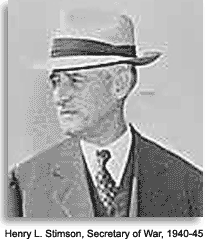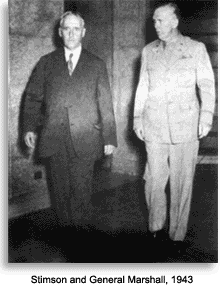Henry L. Stimson was born on September 21, 1867, in New York City, where he spent most of his youth. He went to school at Phillips Andover Academy and to Yale University where he graduated in 1888. He then went on to study at Harvard Law School to pursue a career as an attorney.
A close friend of Theodore Roosevelt, Stimson was appointed to become the United States District Attorney for the Southern District of New York in 1895. During his time there, he made fundamental contributions. Those contributions were not well known by the public, but they helped to strengthen the federal government in the need to reshape American capitalism.
In 1898, Stimson enlisted in the New York National Guard and served until 1907. He then served in the U.S. Army during World War I. Armed with his first-hand knowledge of war, Stimson went on to serve as Secretary of War under President Taft from 1911 to 1913. Stimson used his experience in the Taft administration to help him advance in the Republican Party. In 1927, he was appointed by President Calvin Coolidge to be the Governor General of the Philippines. He served until 1929.
 From 1929 to 1933, Stimson served as Secretary of State under Herbert Hoover. During that time, he became opposed to the seizure of Manchuria by Japan in 1931. He wrote what became known as "The Stimson Doctrine," which stated that the United States would not recognize any changes made in violation of treaties.
Hoover believed that such a doctrine would trigger an economic boycott against Japan and did not approve of the statement. Although he was unable to get the document accepted by Hoover, Stimson later became Secretary of War under Franklin D. Roosevelt and successfully urged him to promulgate it in 1940. Japan refused to acknowledge the document and did not want to yield to any pressure, which was a factor in the attack against Pearl Harbor.
In 1940, President Roosevelt made an attempt to get political parties united behind his policies by appointing Stimson to be the Secretary of War, even though Stimson was a prominent member of the Republican Party — in a Democratic administration. Stimson served until 1945, when he continued under incoming President Truman.
From 1929 to 1933, Stimson served as Secretary of State under Herbert Hoover. During that time, he became opposed to the seizure of Manchuria by Japan in 1931. He wrote what became known as "The Stimson Doctrine," which stated that the United States would not recognize any changes made in violation of treaties.
Hoover believed that such a doctrine would trigger an economic boycott against Japan and did not approve of the statement. Although he was unable to get the document accepted by Hoover, Stimson later became Secretary of War under Franklin D. Roosevelt and successfully urged him to promulgate it in 1940. Japan refused to acknowledge the document and did not want to yield to any pressure, which was a factor in the attack against Pearl Harbor.
In 1940, President Roosevelt made an attempt to get political parties united behind his policies by appointing Stimson to be the Secretary of War, even though Stimson was a prominent member of the Republican Party — in a Democratic administration. Stimson served until 1945, when he continued under incoming President Truman.
 When Stimson was 74 years old, the United States entered World War II. From December 1941 onward, Stimson energetically organized American industrial and economic resources to press the fight against Germany and Japan. Even given his efforts to help fight the war, Stimson feared that Europe would not survive the Allied devastation and that the European economy, most of all German economy, would be completely destroyed.
When U.S. carpet bombing against civilians and the resultant firestorms became a tool for prosecuting the war, Stimson objected to it on moral grounds. He feared that the United States would be charged with war crimes against Germany and Japan. On March 9th, 1945, bombing raids were commenced on Tokyo residents. The city literally caught on fire. Stimson was amazed at the small amount of protest heard from U.S. citizens.
Henry L. Stimson died in Washington, D.C. on October 20, 1950.
When Stimson was 74 years old, the United States entered World War II. From December 1941 onward, Stimson energetically organized American industrial and economic resources to press the fight against Germany and Japan. Even given his efforts to help fight the war, Stimson feared that Europe would not survive the Allied devastation and that the European economy, most of all German economy, would be completely destroyed.
When U.S. carpet bombing against civilians and the resultant firestorms became a tool for prosecuting the war, Stimson objected to it on moral grounds. He feared that the United States would be charged with war crimes against Germany and Japan. On March 9th, 1945, bombing raids were commenced on Tokyo residents. The city literally caught on fire. Stimson was amazed at the small amount of protest heard from U.S. citizens.
Henry L. Stimson died in Washington, D.C. on October 20, 1950.